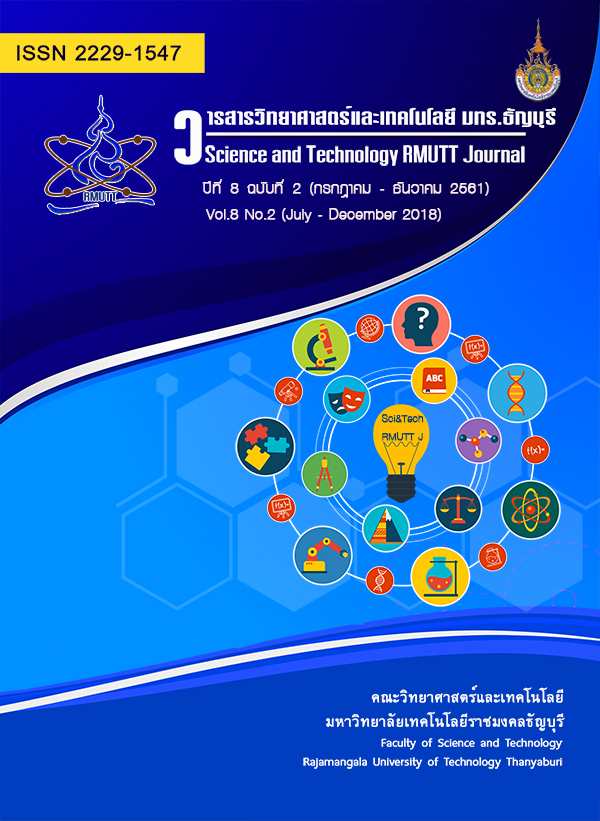Immobilization of poly(L-lactide)-degrading enzyme from Laceyella sacchari LP175: characterization and evaluation for hydrolysis of poly(L-lactide) polymer
Main Article Content
Abstract
Poly(L-lactide) (PLLA)-degrading enzyme from the thermophilic filamentous bacterium, Laceyella sacchari LP175, was entrapped in calcium alginate beads and characterized using emulsified PLLA as a substrate. The 1.0% sodium alginate appeared to be the most effective for the immobilization, with 60% actual immobilization efficiency and 80% theoretical immobilization efficiency. Immobilized enzyme represented emulsified PLLA hydrolyzing activity similar to free enzyme. The immobilized enzyme showed an operational stability up to five times that of the free enzyme, indicating that it is a suitable choice for applications to hydrolysis the PLLA polymer due to reduced enzyme preparation costs. The optimum temperature and thermal stability of the immobilized PLLA-degrading enzyme were shifted from 60 to 65 oC and 55 to 70 oC, respectively, while the pH optima and stability remained unaltered. The immobilized enzyme showed a higher stability at 60 oC for up to 12 h and improved the lactic acid tolerance ability up to 10% (v/v) as compared to the free enzyme which could help avoid lactic acid feedback inhibition during hydrolysis. Hence, the PLLA-degrading enzyme from L. sacchari LP175 was more stable after immobilization and represented a highly appropriate choice for the recycling process of emulsified PLLA polymer.
Article Details
References
Lomthong T., Hanphakphoom, S., Kongsaeree P., Srisuk N., Guicherd M., Cioci G. andKitpreechavanich, V. Enhancement of poly (L-lactide)-degrading enzyme production by Laceyella sacchari LP175 using agricultural crops as substrates and its degradation of poly (L-lactide) polymer. Polym Degrad Stab. 2017. 143: 64-73.
Youngpreda A., Panyachanakul T., Kitpreechavanich V., Sirisansaneeyakul S., Suksamrarn S., Tokuyama, S. and Krajangsang S. Optimization of poly (dl-lactic acid) degradation and evaluation of biological re-polymerization. J Polym Environ. 2016. 1-9.
Panyachanakul T., Kitpreechavanich V., Tokuyama,S. and Krajangsang S. Poly (DL-lactide)-degrading enzyme production by immobilized Actinomadura keratinilytica strain T16-1 in a 5-L fermenter under various fermentation processes. Electron J Biotechnol. 2017. 30: 71-76.
Qi X., Ren Y. and Wang X. New advances in the biodegradation of Poly (lactic) acid. Int Biodeterior Biodegrad. 2017. 117: 215-223.
Shukla R.J. and Singh S.P. Structural and catalytic properties of immobilized α- amylase from Laceyella sacchari tsi-2. Int J Biol Macromol. 2016. 85: 208-216.
Homaei A.A., Sariri R., Vianello F. and Stevanato, R. Enzyme immobilization: an update. J Chem Biol. 2013. 6: 185-205.
Daâssi D., Rodríguez-Couto S., Nasri M. and Mechichi T. Biodegradation of textile dyes by immobilized laccase from Coriolopsis gallica into Ca-alginate beads. Int Biodeterior Biodegrad. 2014. 90: 71-78.
Massolini G and Calleri E. Immobilized trypsin systems coupled on-line to separation methods: recent developments and analytical applications. J Sep Sci. 2005. 28: 7–21
Bibi Z., Qader S. A. U. and Aman A. Calcium alginate matrix increases the stability and recycling capability of immobilized endo-β-1,4-xylanase from Geobacillus stearothermophilus KIBGE-IB29. Extremophiles. 2015. 19: 819-827.
Sukkhum S., Tokuyama S. and Kitpreechavanich, V. Development of fermentation process for PLA- degrading enzyme production by a new thermophilic Actinomadura sp. T16-1. Biotechnol Bioprocess Eng. 2009. 14: 302–306.
Hanphakphoom S., Maneewong N., Sukkhum S., Tokuyama S. and Kitpreechavanich V. Characterization of poly(L-lactide)-degrading enzyme produced by thermophilic filamentous bacteria Laceyella sacchari LP175. J Gen Appl Microbiol. 2014. 60:13-22.
Zdarta J., Meyer A.S., Jesionowski T. and Pinelo M. A general overview of support materials for enzyme immobilization: Characteristics, properties, practical utility. Catalysts. 2018. 8: 92.
Singh S. A comparative study on immobilization of alpha amylase enzyme on different matrices. Int J Pl An Env Sci. 2014. 4: 192-198.
Noreen S., Asgher M., Hussain F. and Iqbal A. Performance improvement of Ca-alginate bead cross-linked laccase from Trametes versicolor IBL-04. BioResources. 2015. 11: 558-572.
Aissaoui N., Landoulsi J., Bergaoui L., Boujday S. and Lambert J.F. Catalytic activity and thermostability of enzymes immobilized on silanized surface: Influence of the crosslinking agent. Enzyme Microb Technol. 2013. 52: 336-343.
Anwar A., Qader S.A.U., Raiz A., Iqbal S. and Azhar A. Calcium alginate: a support material for immobilization of proteases from newly isolated strain of Bacillus subtilis KIBGE-HAS. World Appl Sci J. 2009. 7: 1281-1286.
Torres‐Salas P., del Monte‐Martinez A., Cutiño‐Avila B., Rodriguez‐Colinas B., Alcalde M., Ballesteros A.O. and Plou F.J. Immobilized biocatalysts: Novel approaches and tools for binding enzymes to supports. Adv Mater. 2011. 23: 5275-5282.
Ahmad R. and Sardar M. Enzyme immobilization: an overview on nanoparticles as immobilization matrix. Biochem Anal Biochem. 2015. 4: 1.
Hettiarachchy N.S., Feliz D.J., Edwards J.S. and Horax R. The use of immobilized enzymes to improve functionality. In Proteins in Food Processing (Second Edition). 2018: 569-597.
Fernandez-Lafuente R. Stabilization of multimeric enzymes: Strategies to prevent subunit dissociation. Enzyme Microb Technol.2009. 45:405-418.
Nakamura K., Tomita T., Abe N. and Kamio Y. Purification and characterization of an extracellular poly (L-lactic acid) depolymerase from a soil isolate, Amycolatopsis sp. strain K104-1. Appl Environ Microbiol. 2001. 67: 345-353.


